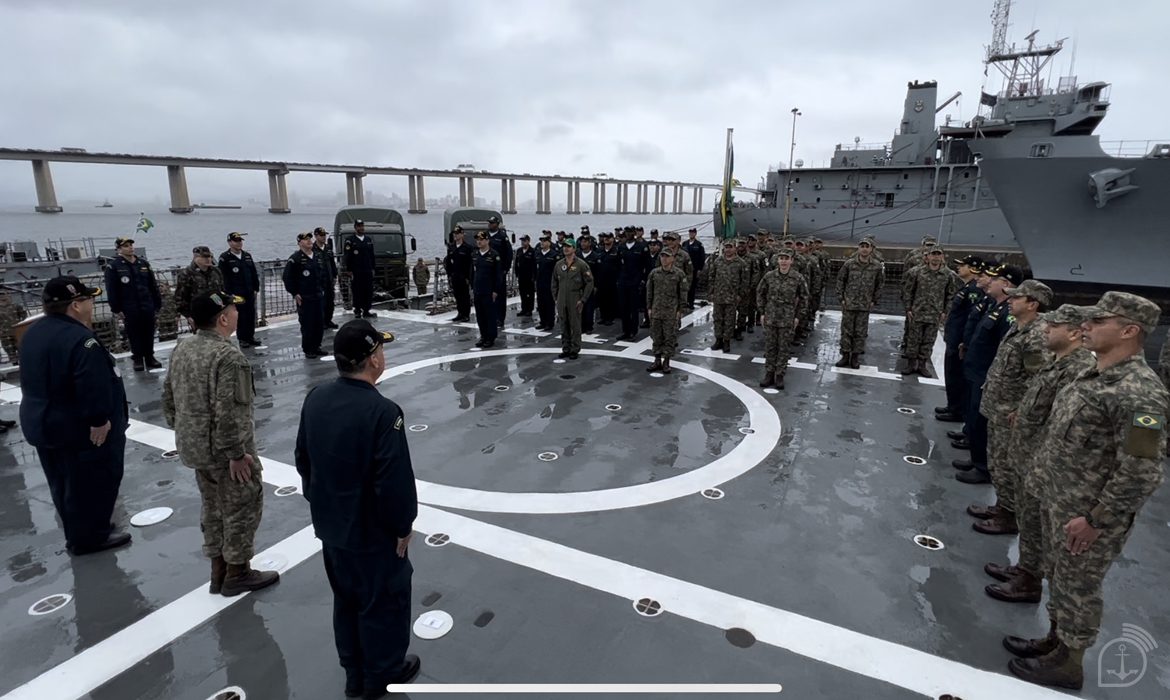Activities start tomorrow (15) and involve agencies and institutions of the federal, state and municipal spheres
By Agência Marinha de Notícias – Niterói, RJ
As one of the agencies participating in the Nuclear Emergency Response Exercise to be held in Angra dos Reis (RJ), the Brazilian Navy (MB, per its Portuguese acronym) activated the Component Naval Force (FNC, per its Portuguese acronym) today (14). The training will take place from August 15 to 18 and aims to constantly improve preparedness, prevention, and, ultimately, response capabilities to a nuclear emergency. The general supervision is of the Institutional Security Office of the Presidency of the Republic (GSIPR), the central body of the Brazilian Nuclear Program Protection System (SIPRON), and involves agencies and institutions of the federal, state and municipal spheres, in addition to the Armed Forces.
This year, the training takes place with the effective movement of naval, aeronautical and marine resources to the scene of action, which, in a joint and interagency effort, will participate in the simulation of emergency situations at the Almirante Álvaro Alberto Nuclear Power Plant (CNAAA), triggering various actions by the agencies involved. The exercise serves to test decision-making and the capacity of emergency centers, as well as to evaluate systems and the prompt use of health, safety, and logistics protocols. MB’s deployment aims to demonstrate the Force’s readiness and capacity in events of this nature, in favor of the safety and protection of nuclear facilities, workers, the population, and the environment.
The event is also an opportunity to test the Navy’s Nuclear, Biological, Chemical, and Radiological Defense System (NBQR, per its Portuguese acronym), which is responsible for this activity in the context of Naval Warfare Operations and Actions, in support of the Navy’s Nuclear Program and Submarine Program, as well as, in a subsidiary way, the National Civil Protection and Defense System and SIPRON itself.
The application of Naval Power will take place in the activities of control and interdiction of the maritime area to be implemented around the CNAAA; maritime security, in the context of the protection of critical maritime infrastructures; and support to State actions, in the context of Civil Defense.
Component Naval Force
In total, the Navy is participating in the event with about 800 military personnel from various specializations and resources from the Fleet Command-in-Chief, the Fleet Marine Force Command, and the 1st Naval District Command. Three ships, a Marine Operational Group, two aircraft, two general cargo landing craft, three “Aviso” type vessels, as well as other support vessels, 30 vehicles and a Field Hospital will be employed.
The FNC is integrated by the Ocean Patrol Vessel “Amazonas”, the Patrol Vessels “Macaé” and “Gurupi”, the Patrol Notices “Albacora” and “Anequim”, the Armored Naval Inspection Boat “Cação”, by the General Cargo Landing Vessels “Marambaia” and “Guarapari”, by the Instruction Notice “Leva Arriba”, by the Teaching and Patrol Support Boat (LAEP), in addition to aquatic motorcycles and semi-rigid hull vessels.
The FNC’s Marine Operational Group is composed of Marine detachments: from the Chemical Biological Radiological Nuclear Defense Center; the Marine Logistics Battalion; the 2nd Marine Infantry Battalion; the Command and Control Battalion; the Air Combat Battalion; the Chemical Biological Radiological Nuclear Defense Battalion; the Marine Corps Engineer Battalion; the Police Company; the Marine Expeditionary Medical Unit; and the Flores Island Marine Base.
The Marine detachments are equipped with the capability to operate the Nuclear, Biological, Chemical and Radiological Decontamination Station; the Beach Detachment Teams; the Traffic Control Posts; the Helicopter Maneuver Teams; the Field Hospital; the Expeditionary Air Base; and the Nuclear, Biological, Chemical and Radiological Mobile Laboratory.
The facilities of the Naval College will also be used, a strategic location where the Joint Command Operations Center will be set up and the first actions will begin; and the Marcílio Dias Naval Hospital, which will operate with its Intensive Care Unit for radio accidents, as it is a national reference for highly complex radiological accidents.
Source: Agência Marinha de Notícias
